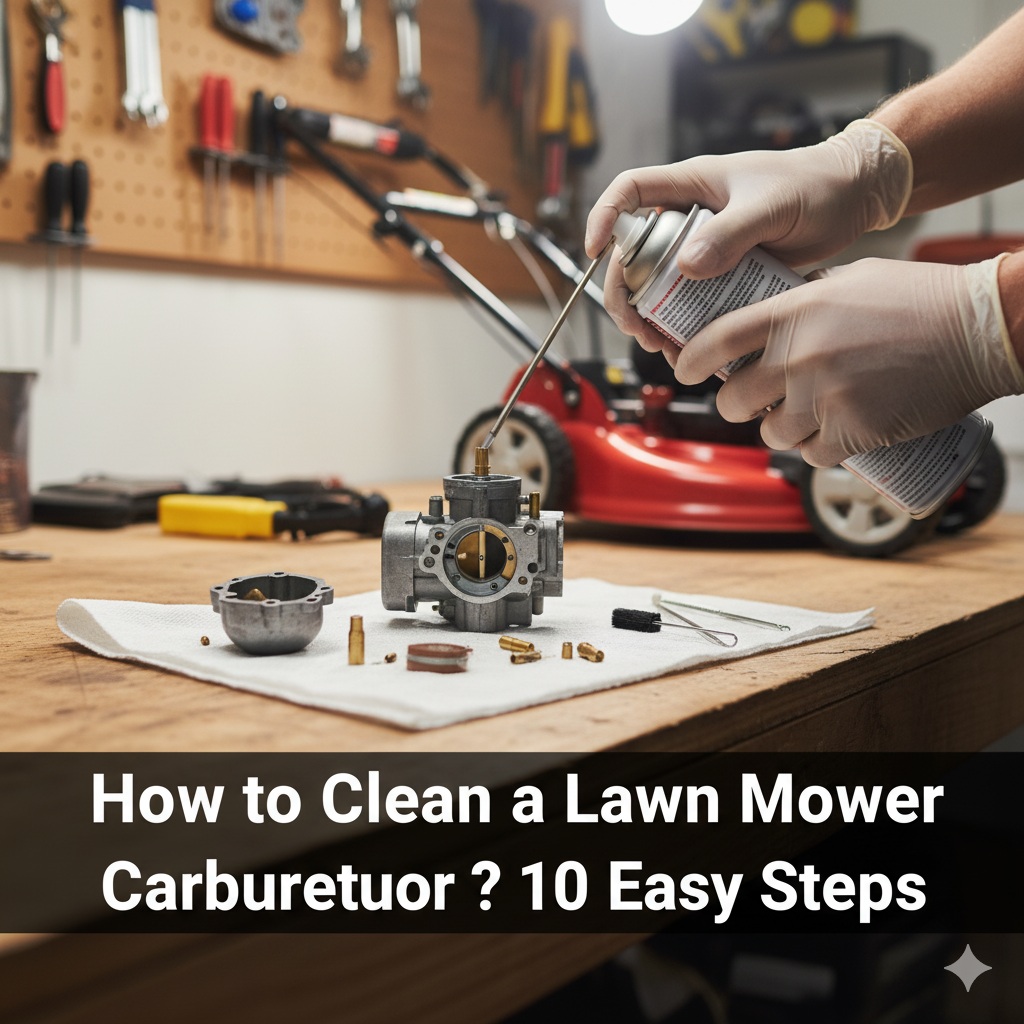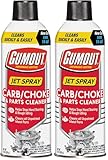
A dirty carburetor is one of the most common reasons why a lawn mower won’t start, stalls, or runs rough. Over time, fuel residue, dirt, and ethanol buildup can clog jets, preventing the correct fuel–air mixture from reaching the engine.
Whether you own a Honda, Briggs & Stratton, Toro, John Deere, Craftsman, or Cub Cadet, the cleaning process is nearly the same — and you don’t always have to remove the carburetor completely.
In this guide, you’ll learn:
✅ 10 easy steps to clean your lawn mower carburetor
✅ How to clean it without removing it
✅ Model-specific instructions for popular brands
✅ Tools, safety tips, and maintenance tricks
⚙️ Why You Need to Clean Your Carburetor
Your carburetor is the “lungs” of your mower — it mixes air and fuel for combustion. When it gets dirty, your mower might:
- Start then die after a few seconds
- Only run with choke on
- Sputter or surge
- Have weak power or black smoke
- Refuse to start entirely
Most of these symptoms are caused by:
- Old gasoline (ethanol attracts water)
- Gummed jets from fuel residue
- Clogged float bowl or needle valve
- Dust/debris from air intake
Cleaning your carburetor restores proper fuel flow and engine performance.
🧰 Tools and Supplies You’ll Need
- Screwdrivers (flathead and Phillips)
- Small socket or nut driver set
- Carburetor cleaner spray (e.g., Gumout, Berryman, Sea Foam)
- Clean rags or shop towels
- Small brush or toothbrush
- Compressed air (optional)
- Safety gloves and goggles
- Fuel-safe container for draining
- New carburetor gasket (if removing carb)
🧠 Tip: If you’re cleaning without removing, you’ll mainly need a screwdriver and carb cleaner spray.
🔟 Step-by-Step: How to Clean a Lawn Mower Carburetor
Let’s break down the full cleaning process — both with and without removal.
Step 1: Disconnect the Spark Plug
Before working on your mower, disconnect the spark plug wire to prevent accidental starting. Safety first!
Step 2: Turn Off the Fuel Supply
If your mower has a fuel shutoff valve, turn it off.
If not, clamp the fuel line using a hose clamp or pliers to stop gasoline flow.
Then, remove the fuel line from the carburetor inlet and drain old gas into a container.
Step 3: Remove the Air Filter Cover
Loosen the screws or clips on the air filter cover.
Remove the air filter and its housing — you’ll now see the carburetor directly behind it.
Check the filter; if it’s clogged, replace it.
Step 4: Inspect the Carburetor Exterior
Before removing anything, spray carb cleaner around the outside to remove surface dirt.
This prevents debris from falling inside later.
💡 If you want to clean without removing the carb:
You can stop after this step and move to Step 5 for “non-removal cleaning.”
Step 5: Clean the Carburetor Without Removing It
If your mower starts but runs rough, this quick method often works.
- Keep the air filter off and open the choke plate.
- Spray carburetor cleaner directly into the throat (air intake).
- Start the mower while spraying short bursts of cleaner.
- Rev the engine a few times to let the cleaner flush through the jets.
- Turn off and repeat if performance improves.
This dissolves varnish and fuel residue inside the carburetor — ideal for quick fixes.
🧠 Pro Tip: Use Sea Foam Spray or Gumout Jet Cleaner for non-removal cleaning; both are safe and highly effective.
- The information below is per-pack only
- Helps Overcome Hard Starting, Rough Idling, Stalling, And High Exhaust Emissions
- Quickly Removes Deposits From The Inside And Outside Of The Carburetor To Improve Engine Performance And Fuel Economy
- Cleans Gum, Varnish, And Dirt From Clogged Carburetors And Choke Valves
- Effectively Cleans Unpainted Metal Parts And Is Quick Drying
Step 6: (Optional) Remove the Carburetor
If the mower still won’t run properly, proceed with a full cleaning.
- Unscrew the bolts holding the carburetor to the intake manifold.
- Carefully detach throttle and choke linkages (note their position).
- Pull the carburetor free, keeping the gasket intact if reusable.
Step 7: Drain and Clean the Float Bowl
- Remove the small nut or screw at the bottom of the carburetor bowl.
- Drain out old fuel — if you see water or debris, that’s the culprit.
- Spray carb cleaner into the bowl and wipe clean.
- Inspect the rubber O-ring gasket; replace if cracked.
Step 8: Clean Jets and Needle Valve
Inside the carb, you’ll see a main jet and a float valve.
- Spray cleaner through every small hole and passage.
- Use a fine wire or needle to gently unclog jets (never use a drill bit).
- Clean the float and needle — they should move freely.
- Blow compressed air through all passages if available.
⚠️ Avoid using metal tools aggressively; small carb holes can be damaged easily.
Step 9: Reassemble the Carburetor
- Reattach the bowl, ensuring gasket fits snugly.
- Reinstall the carburetor onto intake bolts.
- Reconnect throttle/choke linkages.
- Reconnect fuel line and air filter housing.
Make sure everything is tight and leak-free.
Step 10: Reconnect Spark Plug & Test
Reconnect the spark plug wire.
Add fresh gasoline (preferably non-ethanol or with stabilizer).
Start the mower — it may take a few pulls as fuel refills the bowl.
Run for 5–10 minutes to ensure smooth idling and acceleration.
If it runs strong and doesn’t sputter — your carburetor is clean and good to go!
🧼 Alternative: Cleaning a Carburetor Without Removal (Quick Spray Method)
If your mower only sputters or stalls occasionally, you might not need a full teardown.
Here’s a faster version:
- Remove air filter for direct carb access.
- Spray carb cleaner into air intake, choke plate, and bowl area.
- Start engine and rev lightly.
- Continue spraying while it’s running to dissolve internal varnish.
- Replace air filter and check performance.
⚙️ Tip: For minor buildup, doing this once per season keeps your carb clean without full removal.
🧩 Model-Wise Carburetor Cleaning Notes
Here’s how cleaning differs slightly among major mower brands:
| Brand / Engine | Carb Type | Cleaning Tip |
|---|---|---|
| Honda (GCV, HRX, HRN) | Float-style carb | Clean main jet under brass screw; soak in cleaner |
| Briggs & Stratton | Classic side-draft carb | Remove bowl; clean jet in bolt hole |
| Toro (Walk-behind) | Plastic carb with primer bulb | Clean bowl and ensure primer line is clear |
| John Deere (Riding) | Twin-barrel carb | Use carb cleaner and compressed air; clean float bowls separately |
| Cub Cadet / MTD | Single-float carb | Spray cleaner through main jet and float chamber |
| Craftsman | Tecumseh / B&S carb | Remove jet bolt; spray through passages |
| Husqvarna | B&S or Honda engines | Use 10W carb cleaner spray; check air intake for dust |
| Kawasaki (Scag, Exmark, Gravely) | Dual-barrel commercial carb | Clean jets with wire, check solenoid pin |
| Snapper / Troy-Bilt | Small B&S carb | Clean fuel bowl; check primer bulb function |
🧾 Signs You Need a Carb Cleaning (Model-Agnostic)
✅ Starts but dies after a few seconds
✅ Needs choke to stay running
✅ Black smoke or rough idle
✅ Loses power under load
✅ Fuel leaks around carb area
✅ Long storage with untreated fuel
If you notice any two of these symptoms, cleaning the carburetor should be your first repair step.
🧰 Maintenance Tips for a Cleaner Carburetor
- Use fresh gas only. Fuel older than 30 days causes varnish buildup.
- Add a stabilizer (like STA-BIL or Sea Foam) if fuel sits for long periods.
- Run the mower dry before winter storage.
- Replace air filters regularly. Dirt intake accelerates carb clogging.
- Check fuel cap vent. If blocked, fuel won’t flow properly.
💵 Average Carburetor Cleaning Cost
| Type of Mower | DIY Cost | Service Shop Cost |
|---|---|---|
| Walk-behind | $5–$10 (cleaner spray) | $40–$80 |
| Riding mower | $10–$20 | $80–$120 |
| Zero-turn / Commercial | $15–$25 | $100–$180 |
| Carb replacement | $25–$75 | $100–$200 |
🧠 Pro Tip: If your carb is heavily corroded or cracked, replacing it is often cheaper than rebuilding.
⚠️ Common Mistakes to Avoid
❌ Spraying carb cleaner into air filter without removing it (damages filter)
❌ Using high-pressure air too close — can dislodge small parts
❌ Mixing old and new gas
❌ Forgetting to replace bowl gasket after cleaning
❌ Using WD-40 instead of carb cleaner (not strong enough to dissolve fuel gum)
🔋 What About Electric or Battery Mowers?
Electric mowers (like EGO, Greenworks, Bosch, or Ryobi) don’t have carburetors — so no cleaning needed!
If an electric mower stalls or won’t run, check the battery, motor cooling vents, or control board instead.
✅ Summary: Carburetor Cleaning Made Simple
| Step | Task |
|---|---|
| 1 | Disconnect spark plug |
| 2 | Turn off or clamp fuel line |
| 3 | Remove air filter cover |
| 4 | Inspect and clean exterior |
| 5 | Spray cleaner into air intake (no removal) |
| 6 | (Optional) Remove carburetor |
| 7 | Drain & clean float bowl |
| 8 | Clean jets and needle valve |
| 9 | Reassemble and reconnect fuel lines |
| 10 | Start mower and test performance |
After cleaning, your mower should start on the first or second pull and run smoothly without stalling.

I’m David man behind Lawn Mowerly; I’ve been dealing with lawnmowers and Tractors with my father since I was a kid. I know every make and model and what each one is capable of and love helping people find the perfect equipment for their needs.

